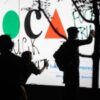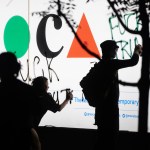
Barbara Rossi, a former Catholic nun whose passion for painting led her to join the amorphous, irreverent group of artists who rose to prominence in the late 1960s and ’70s as the Chicago Imagists, has died at eighty-three. Rossi is best known for painstaking compositions whose sensual, interpenetrating forms whimsically straddle figuration and abstraction, grotesquerie and grace. Her work was as inspired by her religious background as it was by the commercial and street culture that stimulated her fellow Imagists. As critic James Yood once wrote in these pages, “Of all the Chicago Imagists, Barbara Rossi has most consistently achieved an equipoise between a mania for technique and a commitment to iconography with profound spiritual implications.”
Born in Chicago in 1940, Rossi attended St. Xavier College, graduating in 1964. Rossi had long planned to become a nun, but she also harbored ambitions to become a painter. Happily, she didn’t have to choose. With the blessing and backing of the church, she enrolled in the graduate painting program at the School of the Art Institute of Chicago in 1968, where, alongside many Imagists, she became deeply influenced by professors Whitney Halstead and Ray Yoshida, who provided an alternative to the prevailing New York trends of Minimalism and Conceptualism by steeping their students in Surrealist, self-taught, and non-Western art as well as vernacular imagery such as tattoos and advertisements. Rossi earned her MFA in 1970 and the next year began teaching at SAIC, where she remained a longtime and beloved professor (she remained a nun for years before eventually deciding to pursue art full-time).
Rossi had exhibited alongside Gladys Nilsson and Suellen Rocca in 1968, but only began formally associating herself with the Imagists two years later, when the impresario Don Baum invited her to participate in “Marriage Chicago Style,” an exhibition-cum-performance at the Hyde Park Art Center that also included Sarah Canright, Ed Flood, Ed Paschke, Rocca, and Karl Wirsum. Rossi also grew close with Imagists Roger Brown, Philip Hanson, and Christina Ramberg, traveling with them to key collections of so-called outsider art in the United States and Europe. Inspired by her experience with fabric arts, she tended to emphasize her paintings’ status as three-dimensional objects, customizing their frames and adorning their surfaces with feathers, sequins, and hair.
Her breakthrough came in the mid-’70s, when she began painting in acrylic on the reverse side of clear Plexiglas, filling in the foreground of the composition first and the background last, with little room for error. Many of these works pile cartoonish and chaotic figures in ambiguous interiors that seemingly bridge the conscious and unconscious, as in Rose Rock, 1972, which was included in a retrospective at New York’s New Museum in 2016; Artforum reviewer Andrew Kachel described its funky forms as “culled from an estuary of dreams.”
An authority on Indian folk art, Rossi traveled to the subcontinent in the ’80s and began further integrating Indian and Persian themes into her work; in 1995, she curated a traveling exhibition devoted to popular painting in India, the first show of its kind. Her own work is in the collection of the Art Institute of Chicago, the Metropolitan Museum of Art in New York, the National Gallery in D.C., the Museum of Fine Arts Boston, and the Los Angeles County Museum of Art, among other institutions.
“I feel like I’ve gone through my life on my eyeballs,” Rossi once said. “I just keep rolling along on my eyeballs. And I don’t know how else to do it.”
This post was originally published on this site be sure to check out more of their content.






